Scratch AMRAAM (Full Scale) Original Design / Scratch Built
Scratch - AMRAAM (Full Scale) {Scratch}
Contributed by Carl Tulanko
Note: This is a condensed version of the information that Carl produced for his Level 3 project. Visit his homepage to read the additional information and enjoy additional pictures.
|
The Project: Military missiles in particular have always been my favorite. I have built many models of military missiles over the years, to include the Amraam, Harpoon, Harm, Phoenix, ARM, Maverick and more to numerous to mention. In addition, I have learned a great deal regarding the design and construction of well built HPR rockets. My goal in this hobby is to be able to model in full scale the missiles I enjoy designing, building and detailing so much and, for this reason, I have decided to achieve the goal of attaining my Tripoli Level 3 certification. My choice of rockets to model is my favorite, the Hughes Aircraft AMRAAM AIM-120 advanced medium range air-to-air missile. The design was to be close to scale while maintaining a stable airframe; a few changes were made to accommodate the availability of materials, eg: I am using 7.5" Phenolic body tube as 7" is not readily available and minor modifications were made to the fin design to improve stability. This site summarizes the efforts taken to insure a strong and safe, yet as close to scale model as possible. TAP PRE-FLIGHT REVIEW CHECKLIST GENERAL: Currently, I hold a Level 2 certification for Tripoli and will attempt my Level 3 certification at the Tripoli Mid-Ohio Goraj launch on March 30th of 2002, which is located in Mechanicsburg, Ohio. Due to the recent loss of the Aerotech Motor facility, this date may have to be postponed until motors are once again available. The flying field has well over 1000 sq. acres of plowed field with near double the size in adjoining fields. Waivers for 8000 feet with a call in to 12,000 feet are usually the norm for this site, which falls well within the guidelines of my attempted altitude of 6400 feet. Request for TAP by a Prefect is not required, since our Prefect is also one of my TAP reviewers and has approved the project. |
 |
ROCKET REVIEW
A. GENERAL
This is a hardcopy version of the Tripoli Pre-flight Review Checklist, which is required prior to the launch of my Level 3 project. Documentation of this project includes conceptual drawings, fin dimensional drawings, components list, detailed materials spec sheets, dimensional airframe drawing, section structural drawings, glue joint drawing, deployment unit drawings, electronics schematic, initial CP drawing, CP drawings for various motors, CP drawing using VCP, Manual calculation of CP using Barrowman equations, CG/CP relationship drawing with certification motor installed, RockSim 5.021 simulation results, Data Capture Form, this Pre-Flight review, scale data information taken from a real AMRAAM at Wright Patterson Air Force Base Museum and a pre-flight checklist. This is the documentation that has been examined by my TAP reviewers and copies of requested materials have been printed and mailed to Kreig Williams and Gary Dickinson for record keeping and reference per their request.
B. AIRFRAME
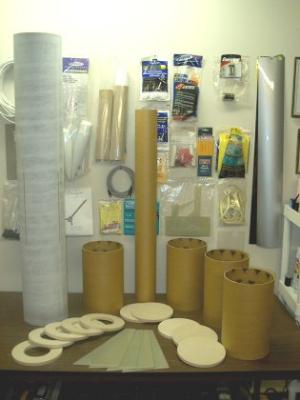 This project consists of a full-scale scratch built model of an AMRAAM/AIM-120 advanced medium range air-to-air missile, which is currently in service by our Armed Forces. Design has been altered from the true scale missile by reducing center fin size and increasing lower fin size to increase stability and CG/CP relationship through a wide range of single motors from L through N class while still maintaining a military look.
This project consists of a full-scale scratch built model of an AMRAAM/AIM-120 advanced medium range air-to-air missile, which is currently in service by our Armed Forces. Design has been altered from the true scale missile by reducing center fin size and increasing lower fin size to increase stability and CG/CP relationship through a wide range of single motors from L through N class while still maintaining a military look.
The airframe will be constructed using PML 7.51” Pre-Glassed Phenolic Body Tubing, which is fiberglassed at the factory with two layers of 6oz cloth, then pre-sanded before shipping. A PML 7.51” Fiberglass Nosecone will cap the airframe and will be permanently fastened to a shorter piece of airframe tubing. The model with consist of three separate four foot sections; a lower section, a center section and a upper section to include the nosecone.
The lower section of airframe tubing will house a 3.9” PML Phenolic Motor Mount tube 36” in length. A total of five PML centering rings comprised of nine ply material with a thickness of one half inch each will support the motor mount inside the lower airframe section and be spaced at twelve inch increments. The bottom of the rocket will double two of these centering rings, thus producing a bottom plate assembly with a thickness of one inch at the base of the model for additional support. Coupling to the next section of airframe will be accomplished using a PML 7.35” Phenolic Coupler, which will be permanently cemented to the inside of the lower airframe section. The inside of this coupler will be fiberglassed with 6oz cloth to provide added strength for the coupled area.
Three separate ½” thick PML Bulkhead plates will be bonded inside the airframe at the lower end of the coupler. Two of these plates will actually be placed inside the coupler and the third plate will cap the outside bottom end of the coupler. This bulkhead assembly is used as a mounting surface for a three inch Stainless Steel U-Bolt, which will be the anchor point for the shock cord. Four separate 3/8” Stainless Steel threaded rods will connect this 1½” thick bulkhead plate to the top motor mount centering ring for additional support.
All centering rings, bulkheads and fins will be bonded to the inside airframe using a combination of glues to include West Systems Epoxy, Jet Epoxy and Aeropoxy. Each centering ring, with the exception of the lower double ring, will have their upper face fiberglassed to the inside of the airframe using 6oz cloth and resin. Moreover, since the lower face of each ring cannot be reached once installed in order to fiberglass, Aeropoxy, an aerospace grade epoxy which does not run and is white in color, will be used as the primary bonding agent to create fillets since it is thixoterpic and thus can hold as a fillet while setting. Additional support for all centering rings and bulkheads will be provided by pinning; each bulkhead and centering ring will be pinned to the airframe through pre-drilled holes by using finishing nails once the plates are cemented to the interior of the airframe. The nails will be glued in the holes and the outside airframe holes will be capped with epoxy resin.
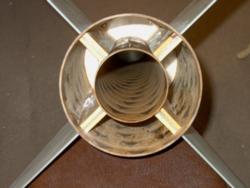 Lower fins will be cut from 1/8” thick G10 Fiberglass and will be mounted through the airframe wall and glued to the motor mount. The area from the outer motor mount surface, up the inside area of the fin and across the inside wall of the airframe will be fiberglassed using 6 oz cloth and epoxy resin and will be applied to all lower fins. In addition, the fins will be glassed to the outside of the airframe using a similar method in order to provide a very strong bond of the fins to the airframe. Finally, epoxy fillets with fiberglass mil will be used to fillet the area where the fin meets the outside airframe.
Lower fins will be cut from 1/8” thick G10 Fiberglass and will be mounted through the airframe wall and glued to the motor mount. The area from the outer motor mount surface, up the inside area of the fin and across the inside wall of the airframe will be fiberglassed using 6 oz cloth and epoxy resin and will be applied to all lower fins. In addition, the fins will be glassed to the outside of the airframe using a similar method in order to provide a very strong bond of the fins to the airframe. Finally, epoxy fillets with fiberglass mil will be used to fillet the area where the fin meets the outside airframe.
The center section of airframe tubing will house both the deployment unit and the canard fins. It will contain a 3.9” PML Phenolic Mount Tube 13.5” in length, which will be used as the outer sleeve for the deployment unit. A centering ring comprised of nine ply material with a thickness of one half inch each will support the lower end of the Mount Tube and will be capped by a nine ply, one half inch thick plywood bulkhead. Two Stainless Steel U-Bolts are installed through both the centering ring and bulkhead for attachment of the shock cord, which will run to the lower section. The upper end of the Mount Tube will be supported by two laminated one half inch thick centering rings, which in turn will have two Stainless Steel U-Bolts installed for the upper section shock cord. Both the fore and aft rings and bulkhead will be reinforced with four 3/8” thick Stainless Steel threaded rods running between them. The aft bulkhead plate will be glassed to the inside of the airframe using 6oz fiberglass cloth and epoxy resin.
The center canard fins will be through-the-wall mounted inside the center section and attached to the deployment unit Mount Tube and at the same time will be wedged between the fore and aft centering rings. Also, the area from the outer Mount Tube surface, up the inside area of the fin and across the inside wall of the airframe will be fiberglassed using 6 oz cloth and epoxy resin and this will be applied to all four canard fins. In addition, the fins will be glassed to the outside of the airframe using a similar method in order to provide a very strong bond of the fins to the airframe. Finally, epoxy fillets with fiberglass mil will be used to fillet the area where the fin meets the outside airframe. Additional support for all centering rings and bulkheads will be provided by pinning; each bulkhead and centering ring will be pinned to the airframe through pre-drilled holes by using finishing nails once the plates are cemented to the interior of the airframe. The nails will be glued in the holes and the outside airframe holes will be capped with epoxy resin.
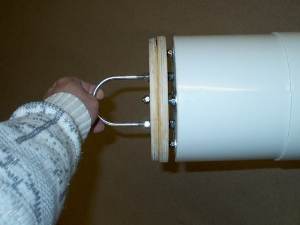 The upper section of airframe will be a simple unit, which will be permanently mounted to the nosecone. A PML 7.51” Fiberglass Nosecone will be bolted and bonded to the upper section using epoxy. A inner bulkhead plate will be glued inside the nosecone flush with it’s base. A second bulkhead plate will be bonded with this plate and a three inch wide Stainless Steel U-Bolt will be installed through both plates prior to them being glued inside the airframe. Next, 6oz fiberglass cloth and epoxy resin will be used to laminate the lower bulkhead plate to the inside wall of the airframe. Additional support for the bulkheads will be provided by pinning; each bulkhead will be pinned to the airframe through pre-drilled holes by using finishing nails once the plates are cemented to the interior of the airframe. The nails will be glued in the holes and the outside airframe holes will be capped with epoxy resin.
The upper section of airframe will be a simple unit, which will be permanently mounted to the nosecone. A PML 7.51” Fiberglass Nosecone will be bolted and bonded to the upper section using epoxy. A inner bulkhead plate will be glued inside the nosecone flush with it’s base. A second bulkhead plate will be bonded with this plate and a three inch wide Stainless Steel U-Bolt will be installed through both plates prior to them being glued inside the airframe. Next, 6oz fiberglass cloth and epoxy resin will be used to laminate the lower bulkhead plate to the inside wall of the airframe. Additional support for the bulkheads will be provided by pinning; each bulkhead will be pinned to the airframe through pre-drilled holes by using finishing nails once the plates are cemented to the interior of the airframe. The nails will be glued in the holes and the outside airframe holes will be capped with epoxy resin.
Finally, a 7.35” Phenolic coupler will be permanently bonded to the inside of the upper airframe, providing a method of connectivity to the center section. This coupler will be glassed on the inside for added strength using 6oz cloth and epoxy resin.
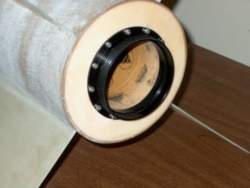 Please note that this is a single motor design rocket, so no clustering is involved in the project. Safety is an extremely important part of airframe construction. A shred could cause property and bodily damage to all with in the launch area. This rocket is being built with materials and methods test proven in the High Power Rocketry community. Additionally, construction techniques have been optimized by the use of pinning the airframe and glassing each upper motor mount centering ring as forces applied will try to push upward in these areas. The same technique applies to the deployment area where fiberglassing has been added to provide additional strength and stainless steel rods have been used for support. The model has been designed with absolute strength in mind and I would like to note that suggestions by my TAP reviewers, which included the pinning of bulkheads/centering rings and the addition of rods to extend from the lower section bulkhead to the upper most centering ring have been taken into consideration and added to the final build and design drawings. These updated documents and drawings have been included in both my documentation and the two sets of documents and drawings forwarded to the TAP reviewers for reference material.
Please note that this is a single motor design rocket, so no clustering is involved in the project. Safety is an extremely important part of airframe construction. A shred could cause property and bodily damage to all with in the launch area. This rocket is being built with materials and methods test proven in the High Power Rocketry community. Additionally, construction techniques have been optimized by the use of pinning the airframe and glassing each upper motor mount centering ring as forces applied will try to push upward in these areas. The same technique applies to the deployment area where fiberglassing has been added to provide additional strength and stainless steel rods have been used for support. The model has been designed with absolute strength in mind and I would like to note that suggestions by my TAP reviewers, which included the pinning of bulkheads/centering rings and the addition of rods to extend from the lower section bulkhead to the upper most centering ring have been taken into consideration and added to the final build and design drawings. These updated documents and drawings have been included in both my documentation and the two sets of documents and drawings forwarded to the TAP reviewers for reference material.
C. RECOVERY SYSTEM
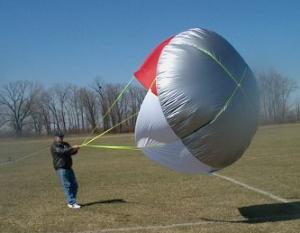 Recovery systems are an integral part of all model rocketry and with an L3 project, which can weigh in excess of fifty pounds, a good system is mandatory. The AMRAAM recovery system will use Stainless Steel hardware and Quick Links rated for this size model. In addition, 5/8” Tubular Kevlar rated at 6000lbs test will be used as the shock cord. Anchoring is achieved using Stainless Steel U-Bolts previously mentioned in the Airframe section of this document. Tubular Kevlar will be tied to the U-Bolt in the lower section of airframe and connected to the end of a “Y” harness of Tubular Kevlar that is fastened to each of two U-Bolts of the center airframe and extends just beyond the bottom of this center section. A minimum of fifty feet of shock cord will be used between the lower and center airframe sections. A Quick Link will be connected to this lower harness to provide easy attachment of a 24” Drogue SkyAngle parachute manufactured by b2 Rocketry.
Recovery systems are an integral part of all model rocketry and with an L3 project, which can weigh in excess of fifty pounds, a good system is mandatory. The AMRAAM recovery system will use Stainless Steel hardware and Quick Links rated for this size model. In addition, 5/8” Tubular Kevlar rated at 6000lbs test will be used as the shock cord. Anchoring is achieved using Stainless Steel U-Bolts previously mentioned in the Airframe section of this document. Tubular Kevlar will be tied to the U-Bolt in the lower section of airframe and connected to the end of a “Y” harness of Tubular Kevlar that is fastened to each of two U-Bolts of the center airframe and extends just beyond the bottom of this center section. A minimum of fifty feet of shock cord will be used between the lower and center airframe sections. A Quick Link will be connected to this lower harness to provide easy attachment of a 24” Drogue SkyAngle parachute manufactured by b2 Rocketry.
The upper airframe section will also have Tubular Kevlar attached to the nosecone U-Bolt through the use of a Quick Link and then connected to the center section of airframe by the use of a “Y” harness of Tubular Kevlar that is fastened to each of two U-Bolts and extends just beyond the top of the center section. A minimum of fifty feet of shock cord will be used between the lower and center airframe sections. A SkyAngle CERT-3 XXLarge Parachute manufactured by b2 Rocketry and made from 1.9 oz. Ripstop Nylon will be used for the main parachute and attached to the shock cord by a Quick Link, which will be tied to the upper Tubular Kevlar harness. A Kevlar Deployment bag will be used with the main parachute to protect it from heat generated by the separation charge. In addition, Biodegradable wadding will be filled to cover each charge used for deployment. Safety is an extremely important part of a recovery system; a failure in the recovery system could cause property and bodily damage to all with in the launch area. For these reasons, a commercial recovery system will be used that is well known for it’s quality and durability; this is a system that has been field tested and proven on many level 3 projects.
D. AVIONICS DESCRIPTION
 Electronics for this project will consist of dual RAS2 Recording Altimeters that are manufactured by Adept. This manufacturer has a reputation of producing some of the best, most reliable altimeters and electronics in the rocketry industry and I have personally been using this particular model for some time now. These are dual deployment altimeters which record all flight data to an on-board non-volatile memory chip and will deploy the drogue chute at apogee and the main chute at a selected altitude, which will be set to 1500 feet. As an additional safety feature, each altimeter comes assembled with an on-board “G” switch, which is used to arm the altimeter charges. Even though the altimeters may be turned on at the pad, the charge circuitry will not arm until forward motion exceeding a duration of .5 seconds is sensed by the G-switch. This gravity switch adds another layer of safety to the project by preventing premature ignition of the deployment charges while the model is placed on it’s launch pad and prepared for launch.
Electronics for this project will consist of dual RAS2 Recording Altimeters that are manufactured by Adept. This manufacturer has a reputation of producing some of the best, most reliable altimeters and electronics in the rocketry industry and I have personally been using this particular model for some time now. These are dual deployment altimeters which record all flight data to an on-board non-volatile memory chip and will deploy the drogue chute at apogee and the main chute at a selected altitude, which will be set to 1500 feet. As an additional safety feature, each altimeter comes assembled with an on-board “G” switch, which is used to arm the altimeter charges. Even though the altimeters may be turned on at the pad, the charge circuitry will not arm until forward motion exceeding a duration of .5 seconds is sensed by the G-switch. This gravity switch adds another layer of safety to the project by preventing premature ignition of the deployment charges while the model is placed on it’s launch pad and prepared for launch.
Each altimeter will have its own separate power source consisting of a new 9 volt Alkaline battery. Both Altimeters will be mounted on opposite sides of a 1/8” thick plate of G-10 fiberglass located in the Deployment Unit. Batteries for the altimeters will be installed , then additionally secured with several wraps of electrical tape for added safety. The altimeters will then be mounted and their respective wiring harnesses for power and deployment will be connected. DaveyFire 28BR Electric Matches will be used for the ignition of the back powder deployment charges. In order to incorporate enough powder charge and dual matches, single BlackSky Research Safe Eject EXP units will be used, one for drogue deployment and on for main deployment. These are rated for Level 3 models, are of a dual match design and can hold up to 20 grams of black powder for a deployment charge. Also, it is my belief that if the charges used to separate the rocket sections are properly tested on the ground, there should not be a need for a secondary charge at each stage of deployment. Redundant charges could lead to the destruction of the rocket or recovery systems. If you have two separate altimeters, each with their own power source, one of those altimeters will light a single charge. If they don't, then a secondary charge really isn't necessary.
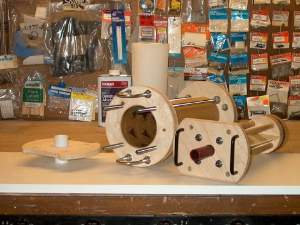 The deployment unit is self-contained and self-sealing, using o-rings to seal each end within the cavity. The unit will be installed and bolted into place and switches consisting of two key switches will be used to turn on the altimeters. All switches will be activated from the outside of the rocket. The altimeters will emit a single long tone during power up; once power up is completed, continuity of ejection charges will be indicated by four short audible beeps from each altimeter, which will repeat in one second intervals.
The deployment unit is self-contained and self-sealing, using o-rings to seal each end within the cavity. The unit will be installed and bolted into place and switches consisting of two key switches will be used to turn on the altimeters. All switches will be activated from the outside of the rocket. The altimeters will emit a single long tone during power up; once power up is completed, continuity of ejection charges will be indicated by four short audible beeps from each altimeter, which will repeat in one second intervals.
Safety is an extremely important part of a electronics system. I consider this the most important part of the rocket as far as safety is concerned. I do not believe that any other possible failure could be as disastrous and cause the greatest injury then the failure of the electronics system, which could result in a rocket returning to earth ballistic. For these reasons, only quality components have been used to construct the deployment unit.
E. MOTOR
The powerplant to produce forward flight will consist of an Aerotech M1419W 98mm reloadable motor. Aerotech is the industry leader in High Powered rocket motors and this particular motor has been used widespread throughout our hobby successfully as a propellant for many large scale rocket projects. In addition, the motor in question has been approved and certified for use by the Tripoli Motor Testing group.
The igniter for this motor will consist of a pyrogen dipped electric match, which will be attached to a three inch piece of Red Thermalite igniter cord. In addition, a strong motor retention system will be used to insure the motor is safely secured to the rocket.
Any possible failures of the motor system would come from incorrect assembly procedures, which could result in a Cato. In order to keep this risk to a minimum, I will request a TAP reviewer is present to supervise the assembly of the motor. Moreover, if the safety distances set by Tripoli are observed and a Cato does occur, then injury or damage to others should not be an issue.
F. LAUNCHER
The rocket will launched from a free standing launch pad suitable for it’s size and weight. A BlackSky Extreme rail with a length of ten feet will provide vertical support for the model and BlackSky extruded aluminum rail buttons rated for a rocket of this size will be used to fasten it to the launch rail. Also, the launch rail will be positioned straight up, perpendicular to the ground and no additional support of the launch system should be required. An estimated weight of the rocket will motor installed is approximately 62 pounds, so a strong launcher that can handle this weight and size will be used to support the airframe.
G. PERFORMANCE
Design of this rocket was based on data collected through research and personal examination of a real AMRAAM, along with practical design changes from design experience incorporated for additional stability. Software was used for the design and simulation results and includes RockSim version 5.021 and VCP, which are two well known applications used extensively throughout or hobby.
RockSim and VCP were used for calculating the center of gravity to center of pressure relationship and manual Barrowman calculations were performed to confirm the results of these software programs. The simulation results were also printed and shown to both TAP reviewers so they could familiarize themselves with the simulated performance data collected for the rocket. Safety implications would include improper relationship of CG to CP, however, the software and design specifications indicate that this model is stable throughout a wide range of motor sizes from L through N.
H. OPERATIONS
A pre-flight checklist is required for all Level 3 certification attempts and should be used will all complex rockets, as it adds an additional margin of safety when assembling these models, insuring that all work has been performed during launch preparation. In Accordance with TAP Pre-Flight Review requirements, the following pre-flight checklist has been prepared and can be viewed, beginning on the next page of this document.
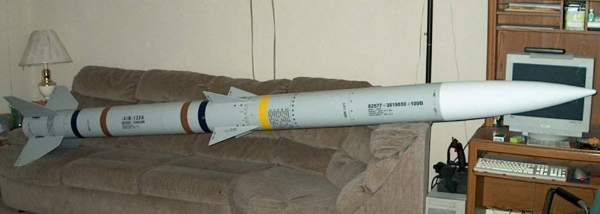
 SUCCESSFUL LEVEL 3 FLIGHT!
SUCCESSFUL LEVEL 3 FLIGHT!
April 27, 2002
Whitakers, NC
Rocket - Scale Amraam
Weight - 70lbs Loaded
Motor - Aerotech M1419W
Altitude 3660 Feet
The day started for me on an upnote as I awoke at dark early in the morning, around 6am, and looked out the window of the hotel room to see blue skies and no wind. I was a bit excited, to say the least, as Ken Parker soon found out. He awoke and we packed a few things in the SUV, then headed to the site knowing we would be the first ones there. A quick stop at the local BK for some coffee and breakfast, then it was off to the field. We arrived around 8:15am and no one was around, that is, except for the cows.
By the time everyone else had certed, I had accomplished loading the four e-matches in the altimeter unit and had placed 4.5 grams of BP in the canister for drogue deployment. I quickly loaded 6.75 grams in the main canister and the altimeter bay was completed. Next, it was inserted into the center airframe, then bolted in and tac-n-stik was used to guarantee the bay would remain sealed during ejection. Shock cords were next as I was meticulously following my pre-flight checklist. Some wadding was added to the lower airframe and the drogue chute was engulfed in Nomex. The lower and center sections of airframe were mated and I proceeded to work on the upper section.
The Aerotech M1419W reload is awesome; it kinda looks like a 54mm reload on steroids! It was easily assembled though and the motor was mounted and retained using a 98mm Aeropak retainer. A quick thanks to Ken Allen for supplying the reload and to the other NC Prefect, Alan Whitmore for getting it to Jim Scarpine, who had it delivered in my hands.
Skies and field were clear and then came the announcement by Prefect, Kelly Mercer. A quick note about Kelly; he also had been at the EXP launch with Mark Lloyd and was a tired guy, but managed to put together one great event and I owe him a ton of thanks for holding the launch. He was busy all day with certs and launches, but still had a good time with it. Thanks much Kelly! My launch was announced first, And nearly everyone except myself was on with a camera. Jim Scarpine had the best seat in the house, doing some close but safe filming. Kent Parker and Courtney were also on video 2 and 3. Well, the count down was on and, just as the M1419 lit, I heard Prefect Kelley Mercer say "...Fire in the Hole!"

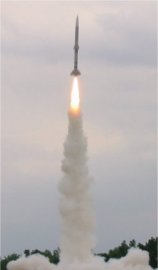 White Lightning motors are so cool; it's like a mini version of a Space Shuttle launch and this was no exception. The AMRAAM took to the skies, slightly windcocking and rocketed up and out. It burned for what seemed forever, then was spotted coasting to apogee. The model seperated and began the tumble down. At 1500', the main charge fired and the big Skyangle XXLarge Parachute filled with air. I could vaguely hear the cheers of the crowd as it all seemed like it was happening in slow motion. It was like watching it in stop frames as the rear of the rocket swung down and it stretched out about 130' in length from top to bottom. A slow rotation could be seen with the main parachute as the AMRAAM settled in the field just behind the tree line where the setup area was located. I do remember Kelly Mercer announcing "...the cows are nodding their heads in approval...!" Everyone laughed at that and it kept the crowd going.
White Lightning motors are so cool; it's like a mini version of a Space Shuttle launch and this was no exception. The AMRAAM took to the skies, slightly windcocking and rocketed up and out. It burned for what seemed forever, then was spotted coasting to apogee. The model seperated and began the tumble down. At 1500', the main charge fired and the big Skyangle XXLarge Parachute filled with air. I could vaguely hear the cheers of the crowd as it all seemed like it was happening in slow motion. It was like watching it in stop frames as the rear of the rocket swung down and it stretched out about 130' in length from top to bottom. A slow rotation could be seen with the main parachute as the AMRAAM settled in the field just behind the tree line where the setup area was located. I do remember Kelly Mercer announcing "...the cows are nodding their heads in approval...!" Everyone laughed at that and it kept the crowd going.
It was a day I won't likely forget and I wanted to say thanks to everyone who attended. Special thanks go to TAP Mark Lloyd and Prefect Kelly Mercer for holding a great event and putting up with us! Even in their state of weariness, they made the launch and I could not have done it without their assistance. Also, thanks go out to the Rocketry Forum guys and personal friends, Ken, Milo, Phil, Mark, Jason and my camera guys, Jim Scarpine, Courtney and Kent Parker. Moreover, thanks to the spouses for putting up with us and to all those who attended and made it a day to remember.
 |
 |
Ken Lord (April 10, 2012)
After speaking with Performance Hobbies, Ken Allen confirmed the 7.5 is 12'
Sponsored Ads
 |
 |












Ken Lord (April 8, 2012)
Enjoyed reading the build. I am waiting for my 7.5" to arive. I understand the 7.5" is 14 1/2' and the 6" is 12' This is according to Performance Rockets. However all data I have seen the 7.5 Is 12'.
However, the build article was a great help